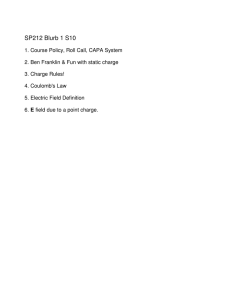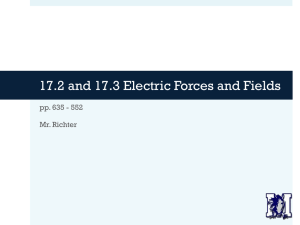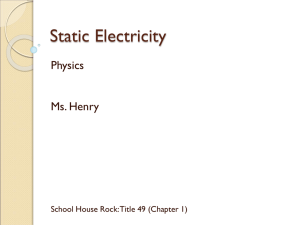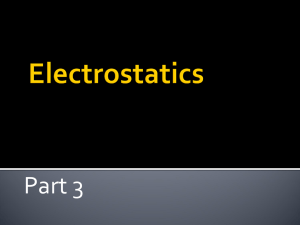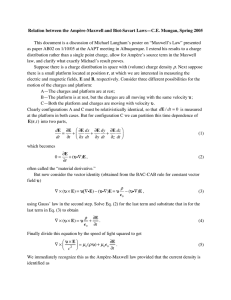Physics 1404: General Physics II • Second Semester builds on the first • Will use many concepts from Phys1403 • New Material includes
advertisement
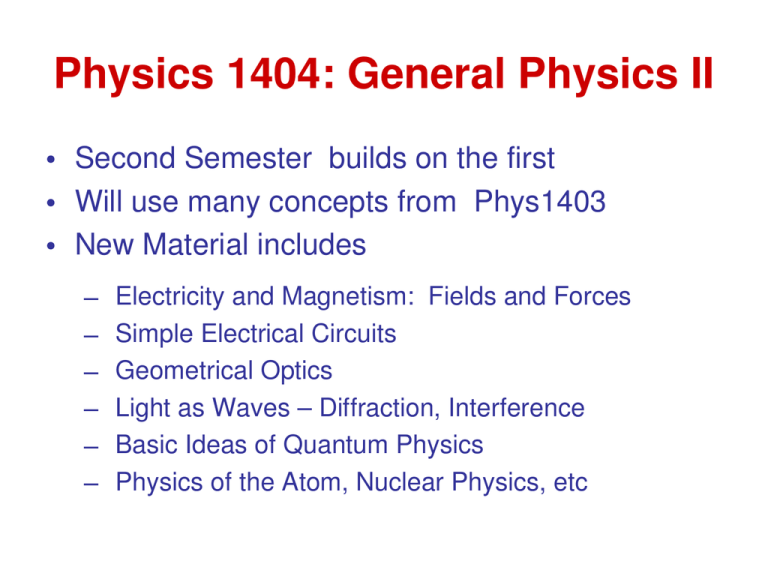
Physics 1404: General Physics II • Second Semester builds on the first • Will use many concepts from Phys1403 • New Material includes – – – – – – Electricity and Magnetism: Fields and Forces Simple Electrical Circuits Geometrical Optics Light as Waves – Diffraction, Interference Basic Ideas of Quantum Physics Physics of the Atom, Nuclear Physics, etc Chapter 16: Electric Charge and Electric Field Chapter 16 ­ 1 • Static Electricity; Electric Charge and Charge Conservation • Electric Charge in the Atom • Insulators and Conductors •Coulomb’s Law; Electrostatic Forces • Solving Problems: Coulomb’s Law and Vectors Static Electricity; Electric Charge and Its Conservation Charge comes in two types, positive and negative; like charges repel and opposite charges attract First Lab deals with these ideas with lots of exercises Static Electricity; Electric Charge and Its Conservation Electric charge is conserved Which means that the arithmetic sum of the total charge cannot change in any interaction. Electric Charge in the Atom Atom: Nucleus (small, massive, positive charge) Electron cloud (large, very low density, negative charge) Electric Charge: Polarized Molecules Polar molecule: neutral overall, but charge not evenly distributed Example: H2O has an ‘electric dipole moment’ due to the charge separation Insulators and Conductors Conductor: Insulator: Charge flows freely Almost no charge flows Metals Most other materials Some materials are semiconductors Coulomb’s Law Experiments show that the electric force between two charges is proportional to the product of the charges and inversely proportional to the square of the distance between them. Coulomb’s Law ­ Details of Math Model Coulomb’s law (based on experiments) This equation gives the magnitude of each force. Q1, Q2 Charges r is distance between the charges k is a constant – depends on unit system Coulomb’s Law: Direction of Forces The force is along the line connecting the charges: attractive if the charges are opposite, and repulsive if they are the same. ID ‘object’ and ‘source’ for each F. Coulomb’s Law Unit of charge: coulomb, C The proportionality constant in Coulomb’s law is then: Charges produced by rubbing are typically around a microcoulomb: How many electrons get transferred? Coulomb’s Law Fundamental charge unit: Electric charge is quantized in units of the electron charge qe= − e or proton charge, qP= +e So, roughly how many electrons in (−) 10− 6 C ? Conceptual Question Two charged objects are separated by a distance d. The first charge is larger in magnitude than the second charge. A) The first charge exerts a larger force on the second charge. B) The second charge exerts a larger force on the first charge. C) The charges exert forces on each other that are equal in magnitude and opposite in direction. D) The charges exert forces on each other equal in magnitude and pointing in the same direction. Coulomb’s Law The proportionality constant k can also be written in terms of , the ‘permittivity of free space’: or What does a − sign mean regarding force directions? rd Law. Also remember Newton’s 3 More Conceptual Questions 1. Two charges separated by a distance d exert mutual attractive forces of F on each other. If these charges are separated by a distance of d/2, what are the new mutual forces? A) F/4 B) F/2 C) 2F D) 4F 2. Two charged objects attract each other with a certain force. If the charges on both objects are doubled with no change in separation, the force between them A) quadruples. B) doubles. C) halves. D) increases, but we can't say by how much without knowing the distance between them. Coulomb’s Law Coulomb’s law strictly applies only to point charges. Superposition: for multiple point charges, forces on any charge (object) from the other charges (sources) can be calculated and then added as vectors. Solving Problems Involving Coulomb’s Law and Vectors Vector addition review: Chapter 16 ­ 2 • The Electric Field • Field Lines • Electric Fields and Conductors • Gauss’s Law The Electric Field The electric field is the force on a small ‘test’ charge, divided by the charge: Basic Definition: The electric field E contains the effects due to the ‘source’ charges and their location re the observation point. The Electric Field For a point charge ‘Source’ at the origin: or Charge Q is the ‘source’ of the electric field. What direction is E ? What does a – sign mean ? The Electric Field Force on a point charge q in an electric field: Superposition principle for electric fields: Results from the superposition of forces and the basic definition of the field E The Electric Field and Coulomb Forces Problem solving in electrostatics: obtaining electric forces and / or electric fields • Define the evaluation point (object charge) • Draw a diagram; show all charges, with signs, and forces acting on the object charge or electric fields at observation pt. with directions • Calculate individual contributions to the force using Coulomb’s law or calculate the Electric Field from each source Q • Add forces vectorially to get result on the ‘object’ charge or add Fields at evaluation pt. Conceptual Question At three times the distance from a point charge, the strength of the electric field is A) nine times its original value. B) three times its original value. C) one­third its original value. D) one­ninth its original value. Electric Field Lines The electric field can be represented by field lines. These lines start on a positive charge and end on a negative charge. Electric Field Lines The number of field lines starting (ending) on a positive (negative) charge is proportional to the magnitude of the charge. The electric field is stronger where the field lines are closer together. Expl: Electric dipole two equal charges, but of opposite sign Electric Field Lines The electric field between two closely spaced, oppositely charged parallel plates is constant (except near edges) We will use this geometry several times E = Q / ε0A A is plate area Electric Field Lines Summary related to field lines: 3. Field lines indicate the direction of the field; the field is tangent to the line. 4. The magnitude of the field is proportional to the density of the lines. 5. Field lines start on positive charges and end on negative charges; the number is proportional to the magnitude of the charge. Electric Fields and Conductors • for a static situation, E = 0 inside a conductor; • any charge resides on the surface. WHY ? 3. the electric field is perpendicular to the surface of a conductor What would happen if E|| is not zero ? Gauss’s Law Electric Flux: Basic Definition Electric flux through an area is proportional to the total number of field lines crossing the area. Gauss’s Law Flux through a closed surface: Gauss’s Law The net number of field lines through the surface is proportional to the charge enclosed, and also to the flux, giving Gauss’s law: This law can be used to find the electric field in situations with a high degree of symmetry. Summary of Chapter 16 • Two kinds of electric charge – positive and negative • Charge is conserved • Charge on electron or proton (magnitude) • Conductors: electrons free to move • Insulators: nonconductors Summary of Chapter 16 • Charge is quantized in units of e • Coulomb’s law: • Like charges repel and unlike charges attract • Electric field is force per unit charge: Summary of Chapter 16 • Electric field of a point charge: • Electric fields can be represented graphically by electric field lines • Static electric field inside conductor is zero; just outside the field is perpendicular to the surface • Electric flux: • Gauss’s law:




